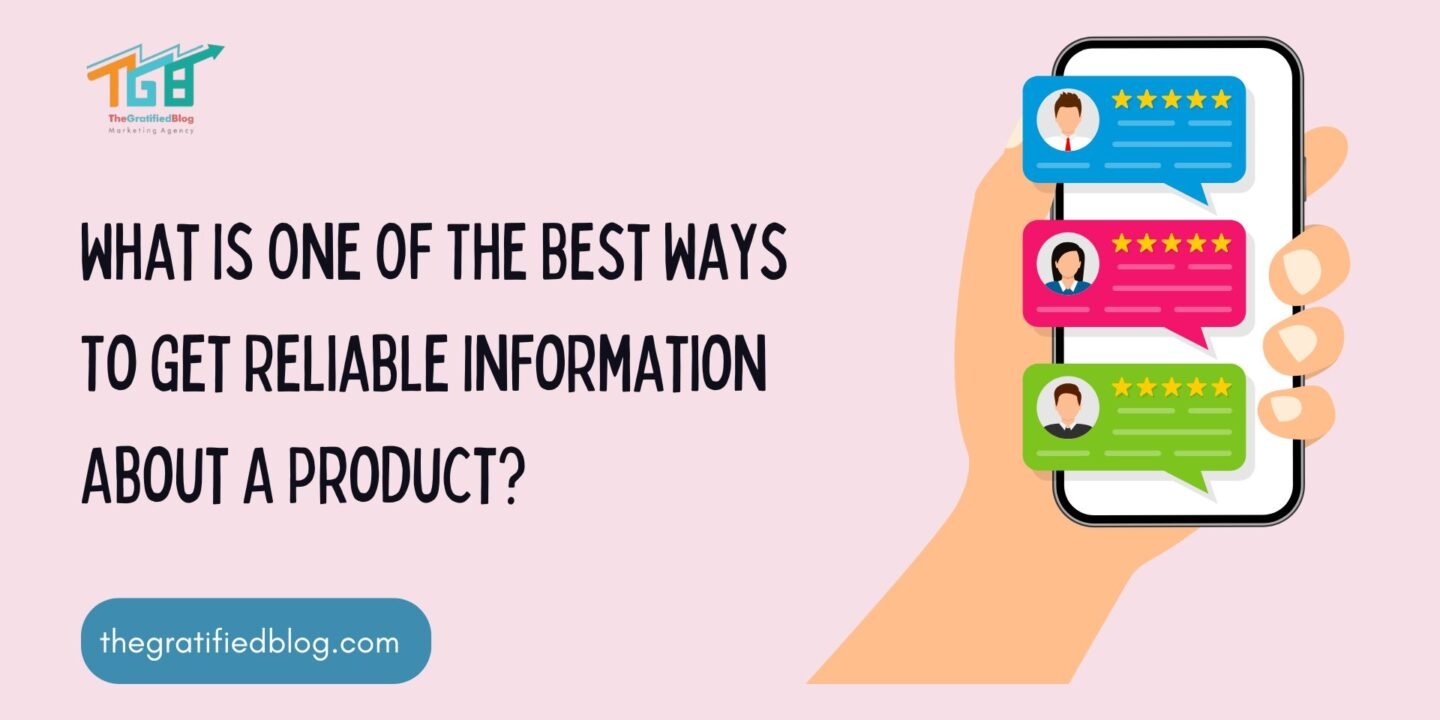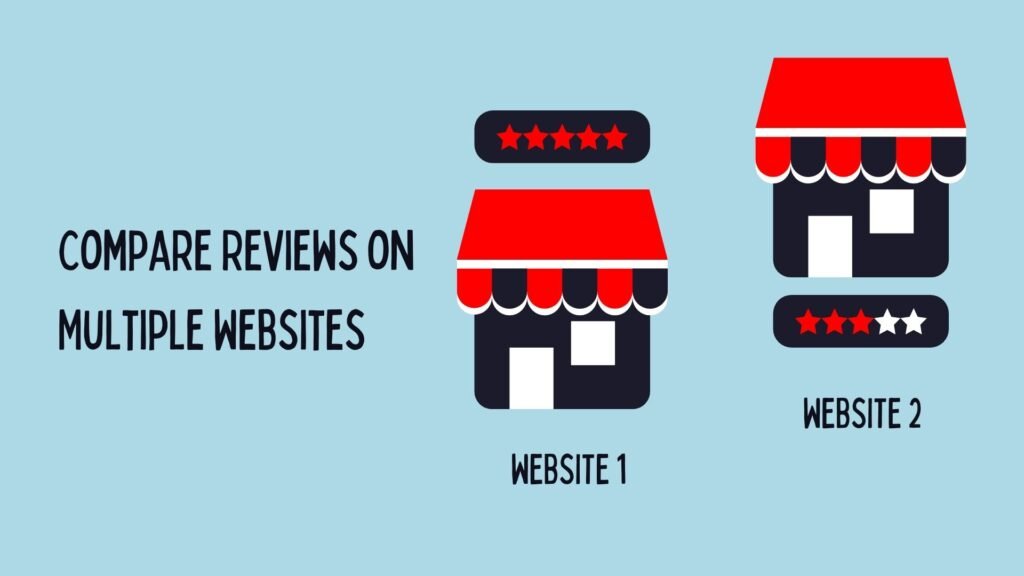
When you are thinking about buying something, whether it is a phone, a laptop, a skincare product, or even a new pair of shoes, you want to be sure you are making the right choice. The last thing anyone wants is to spend money on something that does not work well or does not match their expectations.
But how do you find reliable information about a product? There are so many sources out there—some are helpful, but many are not. In this blog, “What is one of the best ways to get reliable information about a product?” we will explore one of the best ways to get trustworthy product information and also discuss other options that can help you make better decisions.
Why Finding Reliable Product Information Is Important?
Finding reliable product information is crucial for several reasons, especially in today’s digital world where misinformation can spread easily. Here’s why it matters:
1. Informed Decision-Making
- Accurate product details help you compare options and make the best choice based on quality, features, and price.
- Without reliable information, you may end up with a product that doesn’t meet your needs.
2. Avoiding Scams and Fake Products
- Many counterfeit or low-quality products are marketed with misleading claims.
- Reliable sources help verify authenticity and prevent falling for scams.
3. Ensuring Safety and Compliance
- Some products, like electronics or healthcare items, need to meet safety regulations.
- Trustworthy information ensures that a product meets industry standards and isn’t hazardous.
4. Better Budgeting and Cost Savings
- Knowing a product’s real value prevents overspending on unnecessary features or overpriced brands.
- Verified customer reviews and expert recommendations help identify products that offer the best value.
5. Satisfaction and Peace of Mind
- When you trust the information you’re using, you feel more confident in your purchase.
- It reduces the chances of post-purchase regret and ensures you get what you expect.
6. Sustainable and Ethical Choices
- Reliable sources can provide insights into a product’s environmental impact, labor practices, and sustainability.
- This helps consumers make choices that align with their values.
7. Effective Problem-Solving and Support
- If an issue arises with a product, accurate information about warranties, return policies, and troubleshooting can save time and frustration.
What Is One Of The Best Ways To Get Reliable Information About A Product?
The best way to find trustworthy details about a product is by reading customer reviews from multiple sources. Real users who have already purchased and used the product can give honest opinions based on their experiences. But not all reviews are reliable, so here are some tips to make sure you are looking at the right ones:
1. Check Verified Buyer Reviews
Many online retailers, including Amazon, Best Buy, Walmart, and eBay, label reviews from customers who have actually purchased the product. These are known as verified buyer reviews, and they are often more trustworthy than random comments you find on social media or discussion forums.
- Why are verified reviews important?
If a review is verified, it means that the person actually purchased the product and is sharing their experience. This reduces the chances of encountering fake reviews written by someone who hasn’t used the product. - Where to find verified reviews?
Websites like Amazon, Best Buy, Target, and Walmart usually indicate whether a review is from a verified buyer. Other platforms, like Trustpilot, Yelp, and Google Reviews, also allow customers to verify their purchases.
2. Look for Detailed, Well-Written Reviews
Not all reviews are useful. Some are too short to be helpful, while others might lack specific details.
- A reliable review is more than just a sentence saying, “Great product!” or “Do not buy this.”
- Look for reviews that discuss:
- Product quality and durability – Does it feel well-made? Will it last long?
- Performance – How well does it function? Does it meet expectations?
- Ease of use – Is it user-friendly? Are there any setup difficulties?
- Value for money – Does it justify its price?
- Potential issues – Any problems or defects?
For example, if you’re buying a laptop, a useful review would mention how long the battery lasts, whether it overheats, and if it runs smoothly for daily tasks. If reviews don’t mention specifics, they might not be that helpful.
3. Compare Reviews on Multiple Websites

Relying on just one website for reviews can give you a biased perspective. Some websites might filter or remove negative reviews, while others may only show the most positive ones.
To get a balanced view, check reviews from multiple platforms, such as:
- Amazon – Great for a variety of products with thousands of user reviews.
- Best Buy – Useful for electronics and home appliances.
- eBay – A marketplace with seller and product reviews for a wide range of items.
- Walmart – Offers verified customer reviews for products across various categories.
- AliExpress – Features international product reviews, though they may require careful analysis for authenticity.
- Target – Includes customer reviews on products across household, fashion, and tech categories.
- Etsy – Great for handmade, vintage, and unique products with seller-specific reviews.
If a product has good reviews across multiple sources, it’s a sign that it’s genuinely worth considering. On the other hand, if you notice mixed reviews, you may want to dig deeper to see why some users are unhappy.
4. Watch Out for Fake Reviews
Not all reviews are genuine. Some companies pay for fake reviews to make their products appear better than they really are. These can be misleading and might cause you to buy a low-quality product.
Here’s how to spot fake reviews:
- Too many 5-star reviews with no negatives – If every review is overly positive without mentioning any flaws, it could be fake.
- Repetitive wording – If multiple reviews use the exact same phrases, they might be paid or automated.
- Vague comments – Fake reviews often use general statements like “Amazing product! Highly recommended!” without mentioning specific features.
- Review patterns – If a product suddenly gets hundreds of 5-star reviews within a short time, it might be suspicious.
Websites like Fakespot and ReviewMeta can analyze reviews and detect possible fake ones.
Other Reliable Ways To Get Product Information
While customer reviews from buyers are one of the best ways to determine if a product is worth purchasing, they’re not the only source of reliable information. Sometimes, reviews can be biased, lack detail, or even be fake. That’s why it’s important to look beyond user reviews and explore other sources to get a complete understanding of a product before making a decision.
Here are some alternative ways to gather trustworthy information about a product:
1. Expert Reviews from Trusted Websites
Consumer review websites are a great source of information, especially for electronics, home appliances, beauty products, and other high-involvement purchases. Many websites conduct hands-on tests and in-depth research before publishing their findings.
Where to Find Expert Reviews?
- CNET – Best for technology, gadgets, and electronics.
- Wirecutter (by The New York Times) – Provides detailed comparisons and buying guides for various products.
- TechRadar – Specializes in tech reviews, including laptops, smartphones, and software.
- Consumer Reports – Conducts independent testing on a wide range of products, from household items to cars.
- Good Housekeeping Institute – Reviews home and kitchen appliances, beauty products, and personal care items.
Why Trust Expert Reviews?
- Detailed Testing – Experts perform thorough tests rather than just relying on personal experience.
- Side-by-Side Comparisons – Reviews often compare multiple products, helping you understand which one is better.
- Pros and Cons Breakdown – Unlike promotional content, expert reviews provide both advantages and disadvantages of a product.
If you’re buying a smartphone, for example, expert reviews can help you compare cameras, battery life, performance, and durability—all backed by lab testing.
2. YouTube Video Reviews – See the Product in Action
Sometimes, reading about a product isn’t enough. You might want to see it in action before making a decision. That’s where YouTube product reviews come in handy. Many tech enthusiasts, beauty influencers, and fitness experts create detailed video reviews that give you a hands-on look at a product’s performance, build quality, and usability.
How to Find Good YouTube Reviews?
- Search for “[Product Name] Review” – This will show reviews from different YouTubers.
- Check Multiple Reviewers – Watch at least 2-3 different videos to get a balanced view.
- Look for Real-World Tests – Some reviewers perform durability tests, speed tests, or real-world comparisons to show how the product works over time.
Popular YouTubers for Different Product Categories
- Tech & Gadgets: Marques Brownlee (MKBHD), Linus Tech Tips, Unbox Therapy.
- Beauty & Skincare: Tati Westbrook, Hyram, James Welsh.
- Fitness & Sports Gear: Jeff Nippard, The Running Channel, Garage Gym Reviews.
- Home & Kitchen Appliances: America’s Test Kitchen, Kitchen Gadgets Reviews.
YouTube reviews are especially helpful for visual products like smartphones, laptops, clothing, and fitness equipment. Seeing how a phone camera performs in real life, how a blender actually blends, or how a pair of running shoes fits can make a big difference in your purchase decision.
3. Asking Friends, Family, and Coworkers
Sometimes, the most honest and reliable feedback comes from people you know and trust. Your friends, family members, or colleagues may have firsthand experience with the product you’re considering. Since they have no reason to exaggerate or hide flaws, their opinions are often more genuine than those found in paid advertisements or influencer promotions.
Why Ask People You Know?
- They Have No Hidden Agenda – Unlike brands, influencers, or salespeople, your friends aren’t trying to sell you anything. They will tell you exactly what they think—whether good or bad.
- They Understand Your Needs – Someone who knows your preferences, habits, and lifestyle can offer personalized advice and suggest whether a product will be a good fit for you.
- You Get Unfiltered Opinions – Unlike online reviews, where people might be paid or influenced to say positive things, your friends and family will give you candid feedback based on their actual experiences.
💡 Example: If you’re looking for a vacuum cleaner, asking a friend who has pets and children will give you practical insights about durability, suction power, and ease of use.
Limitations
While recommendations from friends and family are valuable, they might not have tested as many products as professional reviewers. It’s always a good idea to double-check with online sources to compare different options before making a final decision.
4. Checking the Official Brand Website
Visiting the official website of a product or brand is one of the most direct ways to gather reliable information before making a purchase. Unlike customer reviews, which can be mixed or biased, the brand’s official website provides detailed specifications, warranty information, and exclusive promotions.
What Information Can You Find?
- Product Features & Specs – Exact details about materials, sizes, colors, and functionalities, which help you compare different models or variations.
- Warranty & Return Policy – Many brands offer extended warranties, money-back guarantees, or flexible return policies, ensuring that your purchase is protected.
- Pricing & Discounts – Some brands run exclusive promotions, seasonal discounts, or bundle deals that may not be available on third-party retailers.
Things to Watch Out For
- Biased Reviews – Some brand websites filter out negative reviews or only highlight positive feedback.
- Marketing Language – Descriptions may exaggerate benefits and downplay flaws, making products sound better than they actually are.
While official websites are great for technical details and policies, it’s always a good idea to cross-check this information with customer and expert reviews to make a well-informed decision.
5. Ask for Recommendations in Online Communities
If you’re still unsure about a product, one of the best ways to get honest and unbiased opinions is by asking real people in online forums and social media groups. Unlike traditional reviews, where some might be fake or sponsored, online communities offer genuine user experiences and detailed discussions.
Where to Ask for Recommendations?
- Reddit – Subreddits like r/buyitforlife, r/productreviews, and r/AskReddit feature in-depth user reviews, product recommendations, and real-life experiences.
- Facebook Groups – Many niche groups focus on specific product categories, such as tech, beauty, home appliances, and fitness gear. Members share their personal opinions and answer questions.
- Quora – You can ask, “Is [Product Name] worth buying?”, and get responses from people who have used it.
- Discord & Telegram Groups – Some communities have dedicated channels for discussing product recommendations.
Since these platforms don’t have a commercial interest, the feedback is often more authentic and reliable than reviews on e-commerce sites. Users also provide comparisons, troubleshooting tips, and long-term usage insights, making it easier to decide if a product is worth buying.
Steps To Take Before Buying A Product
Now that you know where to find reliable product information, it’s time to put that knowledge into action. Buying a product—especially an expensive one—requires careful research and consideration to avoid disappointment. Here is a detailed step-by-step guide to help you make the best buying decision.
Step 1: Identify What You Need
Before you even start looking at products, take a moment to clearly define what you need. Ask yourself:
- What are the must-have features for this product?
- Do I need a basic version or a high-end model?
- What is my budget, and how much am I willing to spend?
- Are there any specific brands I prefer or want to avoid?
💡 Example: If you’re buying a laptop, think about whether you need it for gaming, work, or general use. A high-performance laptop for gaming will be different from a lightweight one for students.
Step 2: Check Multiple Reviews
Never rely on a single review. Instead, check multiple sources to get a well-rounded view.
- Read customer reviews on platforms like Amazon, Best Buy, and Trustpilot.
- Watch YouTube videos to see real-world product demonstrations.
- Look for expert reviews on trusted websites like CNET, TechRadar, and Wirecutter.
📌 Tip: Be cautious of overly positive or one-sentence reviews. The most valuable reviews are detailed and mention both pros and cons.
Step 3: Compare with Alternatives
There might be a better or more affordable option available. To make sure you’re getting the best value for your money:
- Use price comparison websites like Google Shopping, PriceGrabber, or Shopzilla.
- Compare similar products from different brands to see which offers the best features.
- Check for sales or discounts—sometimes waiting a little longer can save you money.
💡 Example: If you’re shopping for wireless earbuds, compare AirPods, Samsung Buds, and Bose alternatives to see which one fits your needs and budget.
Step 4: Verify the Seller
Not all sellers are trustworthy, so before making a purchase:
- Buy from official brand stores or authorized retailers like Walmart, Target, or Best Buy.
- Check seller ratings and reviews on marketplaces like Amazon and eBay.
- Avoid third-party sellers with no history or negative feedback.
📌 Tip: If a deal seems too good to be true, it probably is. Be wary of fake or counterfeit products, especially in electronics and designer goods.
Step 5: Read the Return and Warranty Policy
Even after thorough research, there’s always a chance the product won’t meet your expectations. That’s why you should always:
- Check the return window—some stores allow 30-day returns, while others have a no-return policy.
- Look for warranty details—a good warranty can protect you from defective products.
- Understand the refund/exchange process—some stores charge a restocking fee or only offer store credit.
📌 Example: If you’re buying a smartphone, check whether the manufacturer offers free repairs or replacements within a warranty period.
Mistakes To Avoid When Looking For Product Information
Even if you use the best sources, there are still some common mistakes that can lead to bad purchases. Avoid these to make sure you are getting the right information.
1. Relying Only on Star Ratings
- A 5-star rating does not always mean the product is great.
- Read the actual reviews to understand why people like or dislike it.
2. Trusting Only One Source
- If you check only one website, you might not get the full picture.
- Compare reviews from different sources to get a well-rounded view.
3. Ignoring Recent Reviews
- A product might have been great last year but poor this year due to quality changes.
- Always check the most recent reviews to see if there are any new complaints.
4. Believing Everything Influencers Say
- Some influencers promote products because they get paid to do so.
- While some give honest reviews, others might exaggerate the positives.
- If an influencer review sounds too good to be true, look for other sources to confirm.
5. Forgetting to Check the Return Policy
- Even after doing research, you might not like the product after buying it.
- Always check if the store offers easy returns in case you need to send it back.
Final Thoughts
Finding reliable product information is not always easy, but if you follow the right steps, you can make smarter buying decisions. The best way is to check real customer reviews from multiple sources, but expert reviews, YouTube videos, and Reddit discussions can also help.
Always take your time to research before buying anything. It might take a little extra effort, but it can save you from wasting money on something that does not work as expected.
Next time you are about to buy something, use these tips to make sure you get the best product for your needs. Happy shopping!
Frequently Asked Questions
Q1. What is one of the best ways to get reliable information about a product?
Ans. One of the best ways to get reliable information about a product is by reading verified customer reviews on different trusted platforms. Additionally, professional review websites, expert blogs, and industry comparisons help provide unbiased insights before making a purchase decision.
Q2. How can you find reliable information about a product?
Ans. To find reliable information, check official brand websites, expert reviews, and user feedback on trusted platforms. Forums like Reddit and Quora also offer real experiences. Additionally, watching video reviews on YouTube and reading third-party comparison articles can help verify product claims.
Q3. How to get information about a product?
Ans. You can get product information from official websites, product descriptions, expert review blogs, and customer feedback on e-commerce platforms. Checking user discussions on forums and watching detailed unboxing or review videos can also provide practical insights before making a purchase.
Q4. What is the most trustworthy source of information about a product’s quality?
Ans. The most trustworthy sources include independent review websites, expert testing platforms like Consumer Reports, and verified buyer reviews on major retail sites. Additionally, looking at professional comparisons, certifications, and third-party quality assessments ensures reliable insights into a product’s actual performance.








No Comments